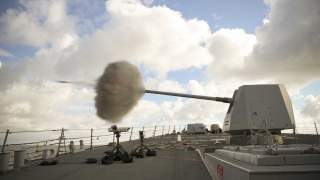China's Navy Is Trying to Simulate a War with America
But does it really come close to the fog of real warfare?
Navies, perhaps more than other services, take decades — at minimum — to physically build and mold into a credible force. And when it comes to tactics, China indeed lags behind the United States.
The People’s Liberation Army Navy has no recent combat experience and no hope of challenging the U.S. Navy on a global scale. The U.S. Navy outnumbers and outclasses China’s sailing branch in practically every category — not just technologically.
(This article by Rober Beckhusen originally appeared at War is Boring in 2016.)
America’s sailors are better trained and have far more practical experience, giving an edge in the event of a future conflict.
But that’s not the whole story. Beijing is slowly and steadily improving how it trains its sailors and how it conducts naval exercises — even putting its people at greater risk than the U.S. Navy— and reforming a stodgy, top-down method structure that inhibits captains’ initiative.
In other words, China is pushing hard to get better at preparing for war. This is worrying for the United States, which already faces the possibilityof defeat or stalemate in a limited, regional conflict with China.
That thesis is central to a recent article by U.S. Navy Capt. Dale Rielage in Proceedings, the influential journal of the U.S. Naval Institute. As the U.S. Pacific Fleet’s director of intelligence, Rielage knows a thing or two about the Chinese military.
The past decade has “seen a major improvement in the scope and complexity of PLAN training that has paralleled the expansion in its missions, operations, and capabilities,” Rielage wrote. “Central to these are high-end naval combat tasks — the fundamentals of fleet action against a foreign navy intervening against People’s Republic of China (PRC) interests. While no training is a perfect facsimile of combat, the PLAN’s proficiency is increasing through this deliberate investment in more advanced and realistic training.”
There is an enormous caveat to this claim, which Rielage is ready to admit. While China can count on new equipment, warships and weapons, how it will deploy them if a shooting war breaks out is far less obvious.
A single vessel, let alone a fleet, is a complicated machine staffed by hundreds or thousands of human beings … who are prone to biases and making mistakes. Wars are inherently confusing and unpredictable — which is why militaries rely on time-tested tactics and procedures to know what to do in actual combat.
Navies, perhaps more than other services, take decades — at minimum — to physically build and mold into a credible force. And when it comes to tactics, China indeed lags behind the United States.
For instance, Chinese commanders often create techniques “on the fly” when learning new technologies, Rielage wrote. Chinese officers often have modern command-and-control systems — thanks to Beijing’s big defense budget — but find them so overwhelming they resort back to older and less efficient methods.
“Chinese military writers frequently criticize ‘formalism’ in training and ‘training for show’ as undermining the value of exercises,” retired U.S. Army Lt. Col. Dennis Blasko wrote in a 2015 article for War on the Rocks. “Despite the progress that the PLA has made in these efforts, the PLA leadership is aware of the force’s continuing shortcomings in training.”
But China is improving. According to Rielage, Beijing is now more often deploys warships as “opposition” forces in exercises. There is now greater emphasis on live-fire exercises, and exercises where a military unit will start out blind as to its adversaries’ numbers and capabilities.
To be sure, the U.S. Navy practices similar techniques all the time, but that’s because the U.S. Navy is a professional, war-ready military force. What Beijing is doing is not revolutionary, but necessary if it wants to challenge America at sea. China is also placing extra of emphasis on training for electromagnetic warfare — jamming radars, radios and satellite-guided systems … and defending against the same.
“In these [Chinese military news] accounts, communications fail and radars are jammed at key moments. The praiseworthy Red [friendly] force responds and overcomes these attacks, or at the least, emerges more capable of surmounting them in the future.”
And the Chinese navy is making its exercises risky — more so than many navies. Communist Party apparatchiks, who have outsized influence over military training, will even reward commanders for breaking the rules if it means winning.
“For example, a North Sea Fleet minesweeping unit was cited for exercising setting and sweeping live mines, accepting increased risk for added realism,” Rielage wrote. “In some cases, these commanders are praised for violating the parameters of an exercise to seize victory.”
“The clear impression is that the PLAN is more willing to accept risk in its training evolutions than its U.S. counterparts,” Rielage noted. “This mindset builds realism but will likely carry a cost in both equipment and personnel.”
The key difference is that the U.S. Navy has far more experience in training and in real warfare. It’s possible China putting a greater priority on realism will give it an edge, or at least match the United States. It’s possible Beijing will solve some of its problems adjusting to modern command-and-control systems. But we will never know unless there is an actual war.
Let’s hope we never find out.
Image: Flickr

